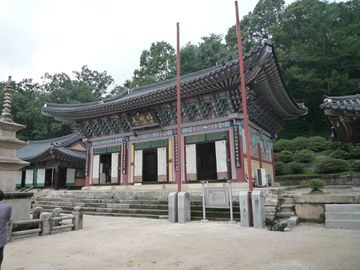"남양주 봉선사 큰법당"의 두 판 사이의 차이
(새 문서: {{진행중}} {{문화유산정보 |사진=남양주봉선사큰법당.jpg |사진출처=[http://www.heritage.go.kr/heri/cul/culSelectDetail.do?ccbaCpno=4413105220000 남양주 봉선...) |
|||
| 38번째 줄: | 38번째 줄: | ||
Generally, a Buddhist worship hall with Sakyamuni Buddha is called Daeungjeon, meaning "Hall of Great Hero." However, this hall has a Korean name Keunbeopdang (lit. "Great Dharma Hall'), which was named by the temple's head monk Unheo (1892-1980). Unheo was a renowned scholar who dedicated his life in translating Buddhist scriptures into Korean language, and he gave this hall a Korean name in a hope to make it sound more friendly to ordinary followers. | Generally, a Buddhist worship hall with Sakyamuni Buddha is called Daeungjeon, meaning "Hall of Great Hero." However, this hall has a Korean name Keunbeopdang (lit. "Great Dharma Hall'), which was named by the temple's head monk Unheo (1892-1980). Unheo was a renowned scholar who dedicated his life in translating Buddhist scriptures into Korean language, and he gave this hall a Korean name in a hope to make it sound more friendly to ordinary followers. | ||
| − | + | Built on the site of the temple's former main hall, which burnt down during the Korean War (1950-1953), this hall was built as a reinforced concrete (RC) building. It is one of the earliest temple buildings built according to the government policy implemented in the 1960s, i.e., allowing the use of modern construction materials such as cement and steel-reinforcing bars even for the construction or renovation of heritage buildings. | |
| − | |||
| − | |||
| − | |||
| − | Built on the site of the temple's | ||
Because it was not usual at the time to use RC construction for traditional architectural works, this temple building had to be completed by assembling precast concrete components made under the supervision of a few masters of traditional Korean architecture. While it is an RC building, the hall displays elaborately copied details of a traditional temple building, including its eaves and rafters. | Because it was not usual at the time to use RC construction for traditional architectural works, this temple building had to be completed by assembling precast concrete components made under the supervision of a few masters of traditional Korean architecture. While it is an RC building, the hall displays elaborately copied details of a traditional temple building, including its eaves and rafters. | ||
| 49번째 줄: | 45번째 줄: | ||
===영문 해설 내용=== | ===영문 해설 내용=== | ||
| − | |||
| − | |||
| − | |||
| − | |||
2020년 10월 15일 (목) 16:50 판
| 남양주 봉선사 큰법당 Main Buddha Hall of Bongseonsa Temple, Namyangju |
|
 남양주 봉선사 큰법당, 국가문화유산포털, 문화재청. |
|
| 대표명칭 | 남양주 봉선사 큰법당 |
|---|---|
| 영문명칭 | Main Buddha Hall of Bongseonsa Temple, Namyangju |
| 한자 | 南楊州 奉先寺 큰法堂 |
| 주소 | 경기도 남양주시 진접읍 봉선사길 32 |
| 지정번호 | 국가등록문화재 제522호 |
| 지정일 | 2012년 12월 14일 |
| 분류 | 등록문화재/기타/종교시설 |
| 시대 | 기타 |
| 수량/면적 | 1동(현황측량면적 251㎡) |
| 웹사이트 | 남양주 봉선사 큰법당, 국가문화유산포털, 문화재청. " |
|
|
|
해설문
국문
남양주 봉선사 큰법당은 불교 대중화에 앞장선 운허(耘虛) 스님이 1970년 조성한 건물로, ‘대웅전’이라는 명칭 대신 ‘큰법당’이라는 한글 편액(종이, 비단, 널빤지 따위에 그림을 그리거나 글씨를 써서 방 안이나 문 위에 걸어 놓는 액자)이 달려 있다.
‘큰법당’은 한국전쟁 때 다 타 버린 대웅전을 철근콘크리트 구조로 새롭게 지은 것으로 형태는 정면 3칸, 측면 2칸이다. 1960년대 정부의 공업화 정책으로 문화재 건축 사업에도 철근콘크리트 구조를 도입한 시대 상황이 반영된 것이다.
철근콘크리트로 전통 건축물을 모방해 제작하는 것은 당시에 일반적인 방식이 아니었다. 따라서 한식 목구조를 이해할 수 있는 몇 사람의 목수가 공장에서 미리 제작한 콘크리트를 현장에서 조립하는 방식(precast concrete, PC공법)을 사용하여 큰법당을 시공하였다. 큰법당은 전통 건축의 추녀 곡선 등 외형적인 측면에서 기존 전통 목조 기법을 정교하게 묘사하였다고 평가된다.
남양주 봉선사 큰법당은 근대 건축 재료와 구조로 전통성을 표현하고자 했던 1960~1970년대 당시의 기술을 대표하는 사료로서 보존 가치가 있다.
영문
Main Buddha Hall of Bongseonsa Temple, Namyangju
This hall, built in 1970, is the main worship hall of Bongseonsa Temple, enshrining Sakyamunu Buddha.
Generally, a Buddhist worship hall with Sakyamuni Buddha is called Daeungjeon, meaning "Hall of Great Hero." However, this hall has a Korean name Keunbeopdang (lit. "Great Dharma Hall'), which was named by the temple's head monk Unheo (1892-1980). Unheo was a renowned scholar who dedicated his life in translating Buddhist scriptures into Korean language, and he gave this hall a Korean name in a hope to make it sound more friendly to ordinary followers.
Built on the site of the temple's former main hall, which burnt down during the Korean War (1950-1953), this hall was built as a reinforced concrete (RC) building. It is one of the earliest temple buildings built according to the government policy implemented in the 1960s, i.e., allowing the use of modern construction materials such as cement and steel-reinforcing bars even for the construction or renovation of heritage buildings.
Because it was not usual at the time to use RC construction for traditional architectural works, this temple building had to be completed by assembling precast concrete components made under the supervision of a few masters of traditional Korean architecture. While it is an RC building, the hall displays elaborately copied details of a traditional temple building, including its eaves and rafters.
Keunbeopdang Hall of Bongseonsa Temple in Namyangju is regarded as a valuable piece of architecture representing the architectural techniques developed in the 1960s and 1970s in an effort to preserve Korean architectural heritage through the use of modern materials and structures.